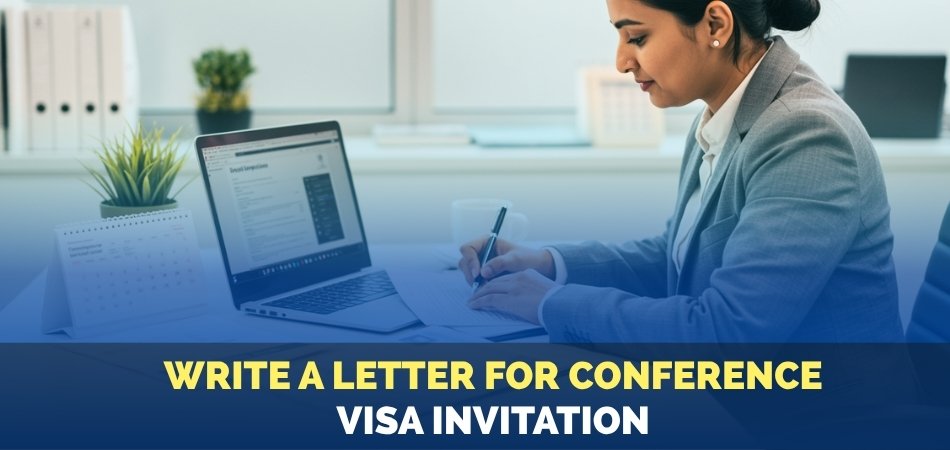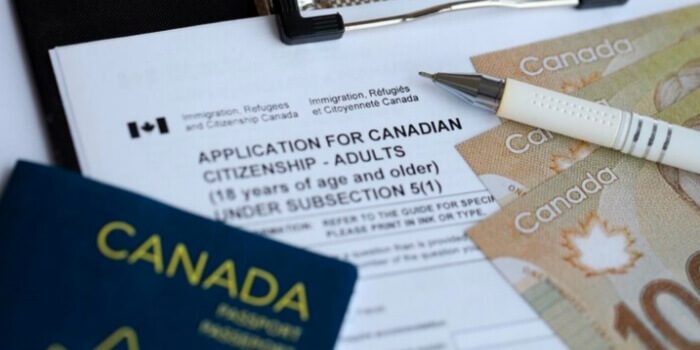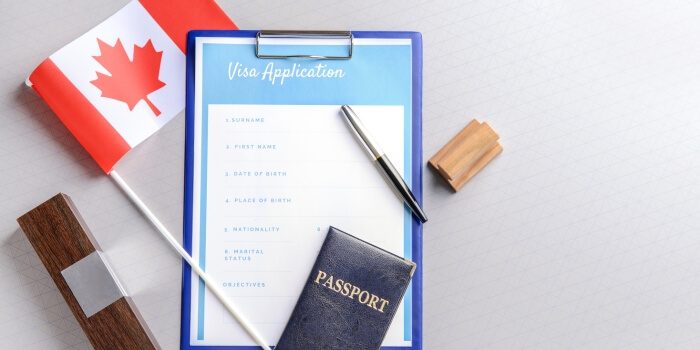A conference visa invitation may seem like a simple document, but it plays a big role in helping someone attend a professional event in another country. It shows the visit has a real reason and supports the visa application. That’s why many people want to know how to write a letter for conference visa invitation?
Write a conference visa invitation letter by including your full name, event details, visit purpose, travel dates, host info, financial support, and accommodation plans. Use a polite tone, simple format, and end with your name and signature.
If you want to understand this topic fully and learn the best way to write such letters, keep reading. This article covers all the important points and helpful tips you need to prepare a strong and successful invitation letter for your conference visa application.
How to Write a Letter for Conference Visa Invitation?
Sometimes, people need a visa to attend events in another country. A visa invitation letter helps prove that you are invited for a real reason. It should be simple, polite, and clearly written with no confusion. Read below to learn how to write one properly and easily.

Personal Details
Make sure you add your full name, address, and contact details correctly. These help the organizers and the visa office match your identity with documents. Your name should always match your passport without spelling mistakes. Include a phone number and email address that work. Clear contact details make it easy if someone needs to reach you. Always check everything twice before sending your invitation letter to avoid delays.
Event Information
You should clearly write the full name of the event in your letter. Include the date, month, year, and the exact place where it will happen. If you are going to a cloud engineering conference, include that name naturally and clearly. Also, write the city and country where the event will take place. Mentioning the correct event information shows that your visit has a real reason and plan.
Purpose of Visit
Tell the reason you want to go to the conference honestly. You may want to learn something useful or meet people from your field. Keep it short and easy to understand, without using fancy words. Just explain how this event can help you in a useful way. The purpose section is very important because it explains why you need the visa clearly and simply.
Travel Dates
Write the dates you plan to arrive in the country and return home. These dates should match the event schedule without being too far off. If you will arrive one day early or leave one day later, say why. This helps show that you have planned your trip carefully. It also tells the visa officer how long you will stay and why.
Host Details
Give the name and contact details of the person or group inviting you. If it is from an organization, the letter should have its official letterhead. If you are getting an international conference invitation letter, make sure it’s from a known group. This helps the visa office trust that your visit is for a real reason. Proper host details make your letter more complete and accepted faster.
Financial Responsibility
Mention who will pay for your trip and stay during the visit. If you are paying by yourself, clearly write that in the letter. If your office or another group is paying, add their name and support details. This helps the visa officer know that your trip is already planned. It also shows you have money support and won’t face problems during your visit.
Accommodation Plans
Include where you will live while you attend the event abroad. If you booked a hotel, write the hotel’s name, address, and phone number. If the event group is giving you a place to stay, write that too. Showing a clear living plan helps the visa officer trust your stay. Make sure you only add real and confirmed information about your accommodation details.
Letter Format
Always keep the letter short, simple, and well organized into small parts. Begin with a greeting like “Dear Sir or Madam” and end politely. Use words that are easy to read and do not sound confusing. Make sure each point is clear and goes in the right order. End the letter with a polite line like “Sincerely,” followed by your full name.
Final Touches
After writing the letter, read everything again to catch small mistakes. Make sure names, addresses, and all dates are written without errors. If you are printing the letter, sign it clearly with a pen at the bottom. A clean, correct letter makes your visa application easier and faster to process.
Check everything carefully before you write your visa invitation letter. Use simple words and always tell the truth in each part. A well-written letter can help you get your visa faster and easier. Don’t rush, take your time, and write it the right way.
Who Can Write a Conference Invitation Letter for a Visa?
Sometimes, you may need a special letter when you plan to attend a conference abroad. This letter helps explain why you’re traveling and who invited you. There are different people or groups who can give you this. Keep reading to learn who they are.
Conference Organizer
The main person or team that can give you an invitation letter is the organizer of the conference. They are the ones hosting the event, so their letter holds the most value. It usually comes with official details like the event name, date, and venue. This letter proves you’ve been accepted to attend and helps a lot when applying for a visa. It’s the most trusted source for a conference invitation letter for visa approval.
Academic Institution
If a university or research center is organizing the event, they may give you the invitation letter on their official paper. This kind of letter often includes your name, what the conference is about, and your role there. It also has the logo and address of the institution. Many embassies like this type because it looks formal and clear, showing you’re going for a real reason.
Professional Groups
Some groups or associations focus on certain fields, like medicine or education. If you’re attending their events, they can send you an invitation too. These groups are trusted and often known worldwide. Their letters usually show the event details and why you’re invited. This helps visa officers see that your visit is linked to a real event, not something fake.
Employer or Sponsor
Sometimes, your job or a group supporting you might give a letter saying they’re helping you attend the event. They might mention they’re paying for your travel or stay. But remember, this kind of letter only supports your application. You’ll still need the official letter from the people running the event to complete your visa process.
Components of a Conference Visa Invitation Letter
People who need to attend conferences in another country usually need a visa. One important document that helps with visas is an invitation letter. Let’s look at what makes this letter clear and helpful.
- Sender’s Information: Start with your name, organization, address, and contact details.
- Recipient’s Information: Include the recipient’s full name, address, and relevant identification numbers (such as passport details).
- Salutation: Begin the letter with a formal greeting, addressing the recipient respectfully.
- Invitation Statement: Clearly state the purpose of the letter, which is to invite the recipient to the conference, providing details such as the conference name, dates, and location.
- Supportive Information: Include any additional information that may support the visa application, such as the significance of the conference, the recipient’s role, and the benefits of attending.
- Closing: End the letter with a polite closing, offering assistance if needed, and providing your contact information for further inquiries.
Before sending out this letter, it’s important to double-check all the details. A simple and correct invitation letter makes the visa process smoother and builds trust with the embassy.
Words and Phrases to Use in a Visa Invitation Letter
Writing a visa invitation letter takes a bit of care and attention. You need to make sure it sounds respectful, honest, and easy to understand. Using the right words helps your letter get taken seriously by officials. Read below to find helpful phrases you can use to keep your letter strong.
Proper Greetings
A good greeting shows respect from the very beginning of the letter. When you’re not sure of the person’s name, “Dear Sir or Madam” works well. But if you know the officer’s name, it’s better to use it. This makes your letter look more prepared and polite. Don’t begin casually, and avoid using short or random greetings. A formal opening sets the tone and makes a strong first impression.
Clear Purpose
Letting the consulate know why you’re writing is very important. You can mention that the person is being invited to a conference, workshop, or seminar. Always add the full event name, location, and exact dates. This helps them clearly understand the reason for the visit. Try not to write anything extra that might confuse the reader. Keep your sentences clean, honest, and focused on the reason for the visit.
Role of the Guest
It’s smart to explain what the invited person will do at the event. You might say they will attend as a registered participant, speaker, or panel member. Mentioning this adds proof that the trip has a real goal. When the role is explained, it shows that the visit is well-planned. Officials like clear, honest letters that don’t sound confusing. That’s why this part matters so much in your letter.
Financial Responsibility
Money matters should be explained in a clean and simple way. If your group is paying for the trip, write that clearly. If the visitor is paying for everything, that’s also fine to say. Be sure to name what parts are being covered, like travel or hotel costs. This helps the officer see that everything is arranged properly. A short, respectful line is enough to cover this important detail.
Ending the Letter
A polite and proper ending gives the letter a smooth close. Say something like “Thank you for your time” or “We appreciate your help.” Always add your name, job title, and full contact details at the end. Keep the words kind but short, and don’t overdo it. You want the letter to finish clearly without sounding too casual. A nice close always leaves a better impression on the reader.
This list helps you make your letter sound clear and respectful. Try using these phrases to keep your writing formal and polite. Don’t forget to check the letter again before sending it out. When your words are simple and honest, your letter works better.
What Is the Ideal Length for a Conference Visa Invitation Letter?
If you are preparing an invitation letter for a conference visa, make sure it is concise, clear, and includes all the information you need to support the visa application. Below is a structured table outlining the ideal length and key components of such a letter:
|
Aspect |
Recommendation |
|
Length |
Approximately 250–400 words, fitting within half to one page. This ensures clarity and conciseness, providing all necessary information without overwhelming the reader. |
|
Format |
Use a formal business letter format: include the date, recipient’s address, salutation, body, closing, and signature. |
|
Font & Spacing |
Employ a professional font like Times New Roman or Arial, size 11 or 12 pt. Maintain 1-inch margins and use single spacing with a blank line between paragraphs. |
|
Host Details |
Include the host’s full name, position, organization, contact information, and official signature. |
|
Guest Details |
Provide the guest’s full name, passport number, nationality, and contact information. |
|
Conference Information |
State the conference name, dates, location, and the guest’s role (e.g., speaker, attendee). |
|
Purpose of Visit |
Clearly articulate the reason for the invitation, such as attending or presenting at the conference, and how it aligns with the guest’s professional or academic pursuits. |
|
Accommodation Details |
Specify where the guest will stay during the visit and who is responsible for the expenses. |
|
Closing Statement |
Conclude with a formal closing, expressing anticipation of the guest’s participation and offering assistance with the visa process. |
By following these guidelines, the invitation letter will effectively support the visa application process, demonstrating the legitimacy and purpose of the visit.
What Type of Language Should Be Avoided in Invitation Letters?
Writing a visa invitation letter needs more than just good details. The way you write your sentences plays a big role. If the words sound wrong or unclear, the letter may lose its value. Let’s look at which language choices you should avoid to keep your letter strong and helpful.
- Too Casual Phrases: Using words like “Hey,” “What’s up,” or “Wanna join” sounds unprofessional and makes your letter feel like a text message.
- Overly Fancy Words: Adding too many difficult words or long phrases makes your letter confusing and hard to follow for the visa officer.
- Unclear Sentences: If your message feels confusing or doesn’t have a clear point, it may not help your visa process at all.
- Too Many Promises: Saying things like “This will change your life” or “You’ll never forget this” sounds too strong and hard to believe.
- Emotional Lines: Adding feelings like “I’ve dreamed of this forever” or “I will be heartbroken” doesn’t help your case and looks dramatic.
- Fake Confidence: Writing phrases like “No visa officer will say no to this” may seem rude or too bold for a formal request.
- Word Repetition: Using the same word again and again makes your letter boring and hard to read, which can also cause confusion.
A strong letter needs the right words to make the right impact. You don’t have to sound smart, just clear and respectful. Avoiding weak or strange words makes your message more trustworthy. Write wisely and let your purpose shine.
Can a Visa Invitation Letter Be Emailed or Must It Be Printed?
When you’re getting ready to apply for a visa, one question often comes up: Does your invitation letter need to be printed, or can it be emailed? The answer depends on the embassy’s rules. Here’s a quick table to help you understand what works in most cases.
|
Format |
Acceptance |
Details |
|
Emailed Copy |
Yes (in most cases) |
Many embassies accept scanned or PDF copies sent by email if they look official and clear. |
|
Printed Original |
Sometimes required |
Some embassies or visa centers may ask for a signed, printed letter with an official stamp or letterhead. |
|
Signed & Stamped Scan |
Often accepted |
A scanned version of a signed and stamped letter is usually fine, especially if emailed from an official address. |
|
Faxed Copy |
Rarely used now |
Few places still accept faxed letters, but it’s mostly outdated. Better to use email or print. |
|
Embassy Rules |
Varies |
Always check with the specific embassy or visa center, as rules can change depending on the country. |
In many cases, emailed invitation letters work just fine, especially if they’re scanned and look official. Still, it’s smart to check with the embassy where you’re applying. Some places may want a printed version with a signature or stamp. Always follow their latest rules to avoid delays.
What to Do If the Visa Is Denied After Sending the Invitation Letter?
Sometimes, even after sending a proper invitation letter, the visa can still be denied. This can feel upsetting and confusing, especially when everything seemed right. But there are steps you can take after that. Keep reading to know what you should do next.
Stay Calm
Visa refusal can feel unfair, but it’s important not to panic or react in anger. Stay calm and take a moment to understand the situation. Many people face visa rejections for different reasons. You still have options to fix or try again. Staying patient helps you make better choices moving forward and keeps your focus clear and steady.
Read the Reason
Always read the refusal letter carefully to know the exact reason. Visa officers usually give a short explanation about why your visa was denied. This reason helps you understand what was missing or wrong. Maybe it was a document, or maybe the letter wasn’t strong enough. Knowing this lets you plan your next steps properly without repeating the same mistake.
Fix the Problem
Once you know the reason for the refusal, try to fix it. If it was a missing paper, gather it for next time. If your letter was unclear, you can rewrite it with better details. Fixing the problem shows that you’re serious about attending the event and can help your second try succeed. Take your time and get everything in order again.
Try Again
If you feel ready, you can apply again with stronger documents. Many people get their visas approved on the second try. Make sure everything is better than before—your papers, your letter, your event plan. Trying again with better care and clearer info increases your chances. This time, double-check everything before you send your new application.
Ask for Help
Ask the event organizer or someone who knows about visas if you’re still unsure what went wrong. They may help you check your papers or improve your letter. Getting help can make your next steps easier and clearer. It also shows that you are trying your best and want to fix the problem in the right way.
Getting a visa denied can feel disappointing, but it’s not the end. You still have ways to fix the issue and apply again. Focus on what went wrong and make your documents better next time. Stay patient and keep trying with clear and honest steps.
Purpose of a Conference Visa Invitation Letter
A conference visa invitation letter is an important document for international events. It helps explain why someone is being invited and what they plan to do. This letter supports the visa process in a big way. Keep reading to learn how it works.
Event Confirmation
The letter shows that the invited person has a real reason to attend. It clearly says the name of the event, when it will happen, and where it will take place. This helps the visa officer know the trip is not random or fake. With all the correct details, it becomes easier to trust the letter. That’s why event confirmation is always a key part of it.
Guest Identification
In the letter, it’s important to explain who the guest is. It should include their full name, passport number, and maybe their job title. These facts help prove the person is real and known by the event host. Giving clear details about the guest also helps avoid any confusion. It builds trust and makes the visa process smoother and more reliable for everyone involved.
Visit Reason
Every invitation letter should clearly explain why the person is being invited. Whether it’s for attending sessions or giving a speech, that reason should be easy to see. A well-written invitation to conference gives a clear picture of the event and the guest’s role. This part shows that the visit has a real and planned purpose. Without a clear reason, the visa could be delayed or even rejected.
Duration Details
A good letter should also mention how long the guest plans to stay. It needs to include travel dates, event dates, and when they will return home. These small details are important for visa officers. It shows that the person doesn’t plan to stay longer than needed. Keeping this part short but clear helps the visa team decide faster and without extra questions.
Contact and Support
The letter should always include contact details for the sender. This can be an email, phone number, or even an office address. If the visa officer has questions, they know who to ask. It shows the organizers are open and ready to help. Having a support contact in the letter adds trust and makes it easier for the visa to be processed without problems.
This guide helps you see what makes the letter so important. Every section in the letter plays a big part in the visa process. Use this to check your letter before giving it to someone else. A clear and complete letter can help get the visa without delay.
Who Needs a Conference Visa Invitation Letter?
Some people think attending a conference is simple, but there are a few things you need to take care of before packing your bags. One important part is getting the right papers. Let’s find out who exactly needs this special letter.
International Attendees
Most people who need a visa to travel will also need this letter. It helps prove that the event is real and that you’ve been invited. Without it, your visa request might be denied. Embassies use this letter to check if you’re truly going to a conference and not for other reasons. If you’re attending an event outside your country, this letter is usually a must for your travel.
Speakers and Presenters
Those who are invited to talk or present something at a conference often need the letter too. It helps show that you’re not just a visitor but someone with an official role in the event. Your name, topic, and session details are usually mentioned in the letter. Having this proof gives your visa application more weight and shows you’re an important part of the event.
Researchers and Academics
People sharing research or studies at a conference also need this letter. It supports your reason for attending and shows the conference values your work. This is important for those going to academic or science-based events. Since the goal is to join people from around the world, anyone in this group will likely need the letter to apply for a visa and attend without any problem.
Students and Scholars
Many students or scholars attend conferences to learn or show their work. Even if you’re not speaking, the letter confirms you’ve been accepted to join. It makes your reason for travel clear and can make your visa process smoother. Sometimes, this step is part of applying for a conference visa, especially when the event is in another country and you’re attending for learning or research.
Sponsored Participants
Some attendees get help from a company or group to join the conference. If you’re one of them, your sponsor might cover your costs, but you’ll still need the letter. It shows that the conference itself has officially invited you. Embassies need to see this to allow your travel. Even with full support, the invitation letter is still a key part of the visa process.
A visa invitation letter can be a small thing, but it plays a big part in getting approved for international events. Make sure you know if you need one before making travel plans. It saves time and stress. Always double-check the visa rules.
Sample of Invitation Letter for Conference Visa
[Date]
[Recipient’s Name]
[Recipient’s Address]
Dear [Recipient’s Name],
Subject: Invitation Letter for [Conference Name]
I hope this letter finds you in good health and high spirits. On behalf of [Your Organization], I am delighted to extend an invitation for you to attend the [Conference Name], which will take place from [Conference Dates] in [Conference Location].
The purpose of this conference is to bring together professionals and experts from [industry/field] to exchange knowledge, discuss emerging trends, and collaborate on innovative solutions. With diverse speakers, interactive sessions, and networking opportunities, the conference promises to be a valuable platform for intellectual growth and professional development.
To facilitate your attendance, we are pleased to provide this official invitation letter to support your visa application process. The [Conference Name] has gained significant recognition in the [industry/field], and we are confident that your participation will further enhance its reputation.
Please find attached the necessary documents, including a copy of the conference program, details of your speaking session, and an official letter of invitation. These documents should assist you in obtaining the appropriate visa to attend the conference. If you require any additional information or assistance, please do not hesitate to contact us.
Thank you for considering our invitation, and we anticipate an exceptional conference experience together.
Warm regards,
[Your Name]
[Your Organization]
[Your Address]
[Your Address]
Commonly Asked Questions
Writing a visa invitation letter for a conference can feel tricky, especially if it’s your first time. Many people have small questions that come up while preparing the letter. Below are helpful FAQs that clear up common doubts and guide you through important details you might miss.
Is It Okay to Use a Template?
Yes, using a template is fine as long as you change the details. Make sure the name, date, event, and contact info are all correct. A template helps you follow the right format, but never send it without editing. Every letter should match your personal situation.
What Happens If I Miss a Detail?
Missing a detail can cause delays or even rejection of your visa. You must include all required parts, like your name, event info, and purpose. Small mistakes can lead to big problems in the visa process. Always double-check your letter before sending it.
Can the Letter Be Very Short?
The letter should be short but not too short. If it’s missing important parts, it might be rejected. You should include clear sections for your personal info, event details, and purpose. A good letter is short, simple, and complete at the same time.
Should I Use My Native Language?
No, always write the letter in English unless the embassy asks for another language. English is the most accepted language for visa documents. If the embassy speaks another language, it will say so on its website. Writing in English keeps things simple and clear.
What Should I Avoid Mentioning?
Avoid writing anything that is not true or not related to the event. Don’t talk about personal feelings or plans not linked to the conference. Keep the letter focused on your invitation and the event. Writing too much can confuse the reader.
Can I Reuse an Old Invitation Letter?
You should not reuse an old letter with past event details. Each invitation letter must match the new conference and your current travel plan. Using old information can hurt your visa application. Always write a fresh letter for every event you attend.
Should I Attach Any Other Papers?
Yes, it’s good to attach papers like your passport copy, event schedule, and registration proof. These help support the details in your letter. Always check the embassy’s checklist to know what to include. Adding extra proof makes your application stronger.
Does the Invitation Letter Need a Stamp?
Some embassies want the letter to be on official letterhead or with a stamp. This shows the letter is real and comes from the right source. If it’s from an organization, ask them to include their logo or stamp. It helps build trust with the visa officer.
Can The Letter Include More Than One Person?
If more than one person is invited, each person should get their own letter. Don’t list several names in one invitation. Each person needs a clear and direct letter with their own details. This keeps things simple and avoids mix-ups at the embassy.
Final Words
Writing a proper visa invitation letter for a conference isn’t hard when you follow the right steps. You just need to keep your message simple, polite, and clear. Adding all the correct details in the right places makes the letter stronger and more trusted by visa officers. Whether you’re attending or inviting, a clear letter helps make the process smooth and stress-free for everyone involved.
So, how to write a letter for conference visa invitation? The answer is simple: just keep it clear, honest, and well-structured. Mention the event name, travel dates, host details, your purpose, and contact info. Use polite greetings and close it nicely. Always double-check everything before you send it. A neat and truthful letter can make a real difference in getting your visa approved.
As a final tip, avoid using confusing or emotional words, don’t leave out dates, and always check names and contact details twice. Print and sign the letter if needed, and always follow the embassy’s rules. Best wishes as you prepare your invitation letter—we hope your conference trip goes well and your visa gets approved without any trouble!








